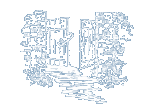|
|
|
|
|
The Structure of Insects
|
|
|
|
|
|
|
|
|
|
|
|
|
|
|
|
|
|
|
|
|
|
|
|
|
|
|
|
|
|
|
|
|
|
|
|
|
|
|
|
|
|
|
|
|
|
|
|
|
|
|
|
|
|
|
|
|
|
|
|
|
|
|
|
|
|
|
|
|
|
|
|
|
|
|

|
|
The Structure of Insects
T
HE insect body is made up of ring-like segments which are grown
together. These segments are divided into groups according to their use
and the organs which they bear. Thus the segments of an insect's body
are grouped into three regions, the head, the thorax and the abdomen.
The head bears the eyes, the antennæ, and the mouth-parts. On each
side of the head of the adult insect may be seen the compound eyes; these
are so called, because they are made up of many small
eyes set together, much like the cells of the honeycomb.
These compound eyes are not found in larvæ. In addition
to the compound eyes, many adult insects possess
simple eyes; these are placed between the compound
eyes and are usually three in number. Often they
cannot be seen without the aid of a lens.
![[Illustration]](http://www.gatewaytotheclassics.com/bronze/books/comstock/insects/comstock_insects_zpage312.gif)
A part of the compound eye of an insect, enlarged.
|
The antennæ or feelers are composed of many segments and are inserted in front of the eyes or between
them. They vary greatly in form. In some insects they are mere threads; in others, like the silk-worm moths,
they are large, feather-like organs.
![[Illustration]](http://www.gatewaytotheclassics.com/bronze/books/comstock/insects/comstock_insects_zpage312a.gif)
Grasshopper, with the parts of the external anatomy named.
|
The mouth-parts of insects vary greatly in structure and in form,
being adapted to the life of the insect species to which they minister.
Some insects have jaws fitted for seizing their prey, others for chewing
leaves, others have a sucking tube for
getting the juices from plants or the
blood from animals, and others long
delicate tubes for sipping the nectar
from flowers.
![[Illustration]](http://www.gatewaytotheclassics.com/bronze/books/comstock/insects/comstock_insects_zpage313b.gif)
The mouth-parts of a grasshopper dissected off, enlarged and named.
|
In the biting insects, the mouth-parts
consist of an upper lip, the labrum,
and under lip, the labium, and two
pairs of jaws between them. The upper
pair of jaws is called the mandibles and
the lower pair, the maxillæ (sing.
maxilla). There may be also within
the mouth, one or two tongue-like
organs. Upon the maxillæ and upon
the lower lip there may also be feelers
which are called palpi (sing. palpus).
The jaws of insects, when working,
do not move up and down, as do ours,
but move sidewise like shears. In
many of the insects, the children are
able to observe the mandibles and the palpi
without the aid of a lens.
![[Illustration]](http://www.gatewaytotheclassics.com/bronze/books/comstock/insects/comstock_insects_zpage313.gif)
A sphinx moth with the sucking tongue unrolled.
Photo by M. V. Slingerland.
|
The thorax is the middle region of the insect
body. It is composed of three of the body segments
more or less firmly joined together. The
segment next the head is called the prothorax, the
middle one, the mesothorax, and the hind one, the
metathorax. Each of these segments bears a
pair of legs and, in the winged insects, the second
and third segments bear the wings. Each leg
consists of two small segments next
to the body, next to them a longer
segment, called the femur, beyond
this a segment called the tibia, and
beyond this the tarsus or foot. The
tarsus is made up of a number of
segments, varying from one to six,
the most common number being
five. The last segment of the tarsus
usually bears one or two claws.
![[Illustration]](http://www.gatewaytotheclassics.com/bronze/books/comstock/insects/comstock_insects_zpage313a.gif)
A tree-hopper, showing the mouth
as a long, three-jointed sucking tube, at a.
|
While we have little to do with
the internal anatomy of insects in
elementary nature-study, the children
should be taught something of
the way that insects breathe. The
child naturally believes that the
insect, like himself, breathes through
the mouth, while as a matter of fact,
insects breathe through their sides.
If we examine almost any insect
carefully, we can find along the sides
of the body a series of openings.
These are called the spiracles, and
through them the air passes into the insect's body. The number
of spiracles varies greatly in different insects. There is, however,
never more than one pair on a single segment of the body, and they do
not occur on the head. The spiracles, or breathing pores, lead into a
system of air tubes which are called tracheæ (tra'-ke-ee), which permeate
the insect's body and thus carry the air to every smallest part of its
anatomy. The blood of the insect bathes these thin-walled air tubes
and thus becomes purified, just as our blood becomes purified by bathing
the air tubes of our lungs. Thus, although the insects do not have
localized breathing organs, like our lungs, they have, if the expression
may be permitted, lungs in every part of their little bodies.
![[Illustration]](http://www.gatewaytotheclassics.com/bronze/books/comstock/insects/comstock_insects_zpage314.gif)
The sphinx caterpillar, with the parts
of the external anatomy named.
|
![[Illustration]](http://www.gatewaytotheclassics.com/bronze/books/comstock/insects/comstock_insects_zpage314a.gif)
|








![[Illustration]](http://www.gatewaytotheclassics.com/bronze/books/comstock/insects/comstock_insects_zpage314a.gif)



